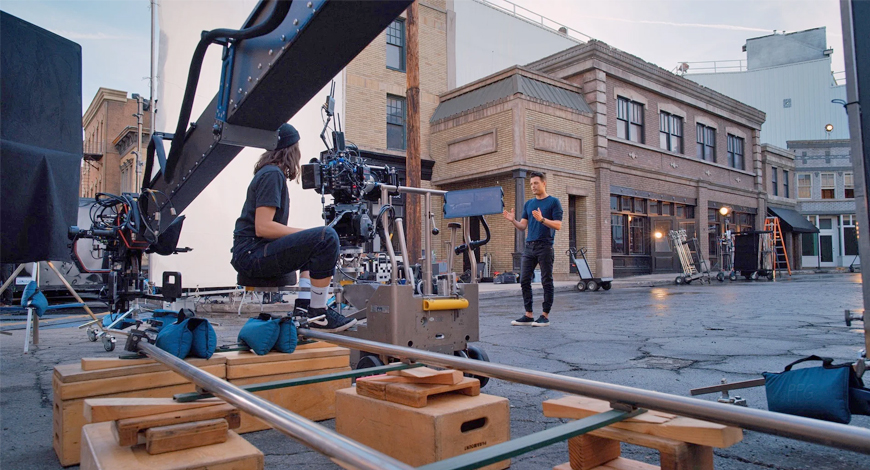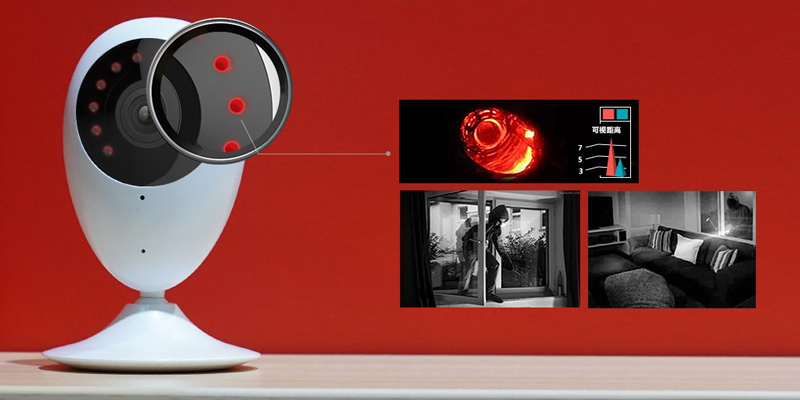BCS Stories
Camera meets Cloud

Camera-to-cloud (C2C) could represent the biggest change in video production since the shifts from film to tape, and from tape to digital filmmaking.
C2C completes the move from a physical workflow to one that is completely digital. It has been technologically possible for several years but has remained dependent on the speed of internet connections and hampered by general reluctance to change.
While the average user expects to be able to instantly upload video files to the cloud, professional film and TV productions use much higher quality footage. This means the size of the formers’ files is enormous and cannot be instantly saved on the cloud. As a result, film and TV professionals rely on hard disks.
C2C technology gets around the problems posed by massive video files by uploading proxy footage that is not nearly so bandwidth-intensive. Such footage can be uploaded over an LTE connection.
This means the film-editing process no longer has to wait on the movement of hard drives. It becomes a linear process that can be done parallelly.
Footage uploaded through C2C can then be edited in C2C software, but the technology is also integrated with popular editing software. And because the proxy footage has the same timecodes and metadata as the original, any edits can be synchronized once the drives are received. In addition, C2C allows production members on and off the set to view footage from their computer, iPhone, or iPad as soon as it is shot.
Also read, Broadcasting via cloud is the new normal, as amply displayed at the Tokyo Olympics
Hence, the C2C workflow enables filmmakers to export original footage into a post environment as soon as it is recorded. Rushes can be reviewed, edited, or otherwise manipulated, and fed back to the set, in minutes, saving time and, therefore, money, and enhancing creative decision making.
Internet access still constrains adoption but the need to cater for COVID-19 safety protocols has shaken the industry’s inertia. In recent months, remote workflows have become a staple of editorial for editing, VFX, and color grading, omg review, and approval, in which craft talent is located out of fixed premises, with freedom to work from anywhere. Now the industry can go a step further and open up collaborative, connected workspaces live from location.
C2C breaks down the barriers of time and distance. What was once a linear process of shooting and waiting for footage to be processed is now a parallel process. With C2C, creative teams can work together collaboratively without waiting to exchange any physical media.
The concept of a cloud-based platform, which can enable even an iPhone to operate as an editing suite, has gained even greater urgency with COVID-19. C2C can keep remote teams truly connected and in sync whether they are shooting on a second unit down the road or sitting in an edit suite thousands of miles away.
There are several benefits in the C2C mantra. Perhaps the most important element is the ability to get shots into the hands of editorial without waiting for the dailies process. This typically implies a DNX 36 and a DNX 115 or similar – something that the editor can slot into their workflow.
Dailies have been the quickest route to on-set creative decision making for decades, but it is called dailies for a reason. Footage is processed often overnight and returned to the set – sometimes resulting in wait times of 24 hours. That is no longer efficient for the pressures of modern production, especially when there is an alternative on tap. The cost of reshoots and additional travel to and from location can easily be 15–20 percent on the bottom line. Anything that helps reduce the cost of pick-up shots by enabling instant creative decision-making is of tremendous value.
C2C’s viability has been demonstrated. During production of 2020 action feature Unhinged, starring Russell Crowe, director Derrick Borte and DP Brendan Galvin used a C2C solution to slash the shoot time allocated for a major car chase sequence in half.
Normally, the crew would have to go back to the video village to get notes then reset the scene. Using a C2C platform they were able to reference the footage of their run as they were resetting, along with notes, and cut the schedule in half.
Similar workflows can be applied to any key production head. Art directors or executive producers, for example, unable to get onto set because of limitations in the number of people permitted, can review progress remotely. C2C further enables them to work at a location of their choosing, or on the go, maximizing their own time while reducing travel costs.
Off-set creatives can be in direct contact with those on-site, providing live feedback that negates the need to go back and forth later down the line. So, teams can feel connected to life on-set with an over-the-shoulder collaboration experience.

If a phone call can be made where a shoot is happening, a C2C shoot can happen in that location. The way the system works is that film professionals can throttle the quality of files up or down, based on network bandwidth availability.
At 2 Mbps, 1080/24p, one hour of content is about 1 GB of total footage. Since crews typically shoot between two and four hours of footage a day (or 2–4 gigabytes of C2C proxies), they can easily upload all the media spread across the shoot day.
Ideally, having anything more than 10 Mbps upload will result in offsite collaborators having access to clips within a minute or two of the take. When higher bandwidth is available, takes are available within seconds. Even a one-hour interview with 10–20 Mbps of upload bandwidth can be fully transmitted in less than 6 min, so the post-production and transcription processes can begin while the crew is still wrapping up.
For higher-quality files like H.265 4K, the same principles apply. 10–20 Mbps is going to be enough for C2C to work. It will be extremely efficiently – enough to eliminate any sense of delay.
While there is a lot of buzz around the camera itself pushing directly to the cloud, it is not an efficient model. This is more likely to occur in small-budget productions, B units off-lot, or production of commercials where there are only one or two cameras.
Most meaningful productions for episodic and features have multiple cameras and are typically using Wi-Fi spectrum to push the data from the camera to the video village where the footage is cached. The director, producer, DoP, DIT, etc., all want to have a look at the take(s) before agreeing to move forward with the next scene or shot.
Additionally, large shoots employ video-assist software to provide for better shot management relative to metadata, multiple camera feeds, scene in/out, etc. Pushing all of the video through a common shot manager is the most common practice for medium and large productions.
While this is all fine for the vast majority of workflows, which work with proxy video, but anyone wanting to push camera RAW (original camera files/OCF) faces an uphill task today.
OCF requires more like 1000 Mbps before it is reliable enough to move. OCFs are not only the largest data payload but the least time-sensitive. Today, OCFs do not come directly from the cameras, but rather are being pushed to a local staging environment (on-set or near-set storage as a part of video village).
Also read : Virtual production is coming of age
When it comes to transmission, the ability to get OCF directly to the cloud is limited today, but it is starting to happen. Companies are working with studios to install ultra-high-speed network connections that enable DITs to upload OCF right from the set. Currently, those transmissions cannot be done wirelessly because wireless networks still lack the appropriate bandwidth.
But there is another thing that needs to be solved before wireless networks catch up – today’s cameras are not yet designed to get OCF up to the cloud without first downloading it. It is predicted that cameras will be developed to allow access to OCFs so that it can be uploaded from the camera itself.
The first step is that camera manufacturers will have to create that technology, and as they make headway, the telecom solutions will continue to increase bandwidth (hardline or wireless) to allow for connections that move OCF right to the cloud.
In about 5–7 years, average bandwidth utilized on set will be suitable for RAW transfers to the cloud, with shooting OCF to the cloud becoming the norm by 2031.
Camera-to-cloud is not predicated on the rollout of 5G. Today, LTE and general Wi-Fi hotspots allow ample bandwidth to move files compressed as H.264 up to the cloud. 5G will, however, help boost adoption of C2C by decreasing bandwidth-dead zones and increasing internet access points. Satellite internet will also further widen the network reach to reduce dead zones in more remote locations.
5G will be great for reality TV shows where the camera(s) are following actors in a major city. This happens today with 4G/LTE, and 5G will make this experience much better for filmmakers on the move in major metropolitan areas.
The first notable production to use C2C was Catchlight Studios’ Songbird, the first Union-crewed film to go into production during COVID, in July 2020. Use cases also include red-carpet coverage of the 63rd Grammy Awards transmitted from Los Angeles to London, and documentary filmmakers using C2C for quickly deriving transcripts from the set so the editing process can begin immediately.
Nonetheless, there are gaps in the workflow. Perhaps the trickiest is the ability for a production to access media assets regardless of which cloud it is stored on. The reality is that until cloud service providers soften their approach commercially (by not charging major players), this will continue to slow cloud adoption because of both the absolute cost and the unpredictable (budget blowing) nature of the egress fees.
The hope is that as more enterprises use cloud, that will push cloud companies to produce an experience that is essentially storage agnostic. This means processing can happen with the service and the media can be stored wherever it is most convenient for the customer. But what remains to be seen is what the costs will be to leverage that kind of flexibility.
An additional hazard is potential loss of data, delays, and even security when moving content between cloud providers.
Perhaps, just as tape conceded to digital filmmaking, in subsequent years, digital filmmaking could make way for C2C. Through C2C technology, workflows will become seamless, resulting in higher production value, quicker production, and lower costs. While mainstream Indian filmmakers and TV professionals have not yet adopted C2C technology in any meaningful way, gradually C2C will find its way into Bollywood productions and might replace current film and TV production workflows.






You must be logged in to post a comment Login